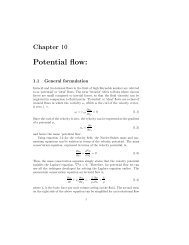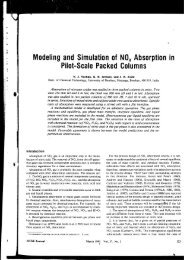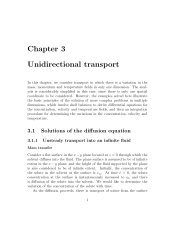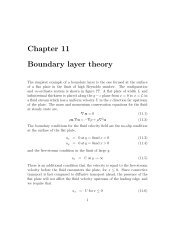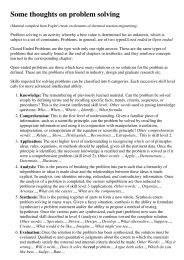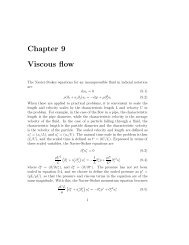Chapter 5 Steady and unsteady diffusion
Chapter 5 Steady and unsteady diffusion
Chapter 5 Steady and unsteady diffusion
Create successful ePaper yourself
Turn your PDF publications into a flip-book with our unique Google optimized e-Paper software.
2 CHAPTER 5. STEADY AND UNSTEADY DIFFUSION<br />
Note that the partial derivatives have now become total derivatives because<br />
F is only a function of t, <strong>and</strong> R, Θ <strong>and</strong> Φ are functions of only r, θ <strong>and</strong> φ<br />
only. The left side of the equation is only a function of t, while the right side<br />
is only a function of (r, θ, φ). Therefore, each side has to be equation to a<br />
constant, say −λ 2 . The solution for F can be easily obtained:<br />
F(t) = exp (−λ 2 t) (5.5)<br />
Note that it is necessary for the constant −λ 2 to be negative for the solution<br />
to be bounded in the limit t → ∞.<br />
The remainder of the equation 5.4 can now be written as:<br />
[ ( ) 1<br />
sin (θ) 2 d<br />
r 2dR + 1 (<br />
1 d<br />
sin (θ) dΘ ) ]<br />
+ λ 2 r 2<br />
R dr dr Θ sin (θ) dθ dθ<br />
= − 1 d 2 Φ<br />
Φ dφ 2 (5.6)<br />
Here, the left side is only a function of r <strong>and</strong> θ, <strong>and</strong> the right side is only a<br />
function of φ. Therefore, both these have to be equal to a constant, say m 2 .<br />
This can be easily solved for the function Φ(φ):<br />
Φ = A 1 sin (mφ) + A 2 cos (mφ) (5.7)<br />
Note that m has to be an integer, because the physical system obtained<br />
remains the same when φ is increased by an angle 2π.<br />
The rest of equation 5.6 can now be written as:<br />
( )<br />
1 d<br />
r 2dR + λ 2 r 2 = − 1 (<br />
d<br />
sin (θ) dΘ )<br />
R dr dr sin (θ) dθ dθ<br />
+ m2<br />
sin (θ) 2 (5.8)<br />
Here, the right side is only a function of θ, while the left side is only a function<br />
of r. Therefore, both sides can be set equal to a constant, n(n + 1). The<br />
equation for Θ then becomes<br />
− 1 (<br />
d<br />
sin (θ) dΘ )<br />
sin (θ) dθ dθ<br />
+ m2<br />
2<br />
= n(n + 1) (5.9)<br />
sin (θ)<br />
The solutions of the above equation are called ‘associated Legendre functions<br />
of degree n <strong>and</strong> order m’:<br />
Θ(θ) = B 1 Pn m (cos (θ) + B 2Q m n (cos (θ) (5.10)





